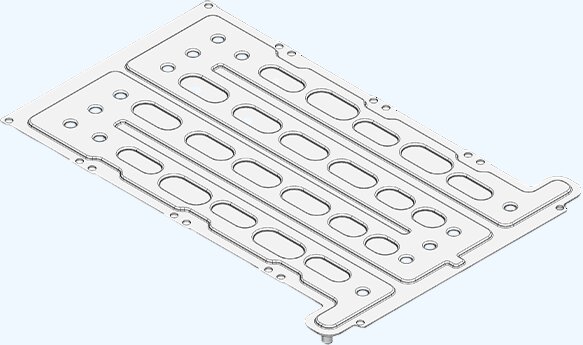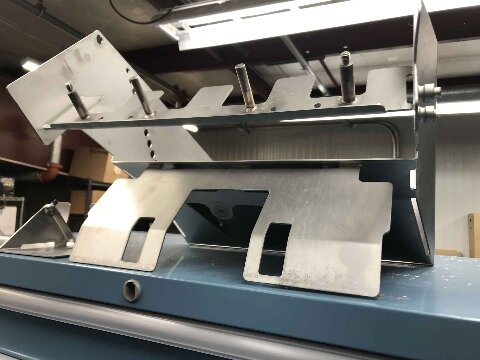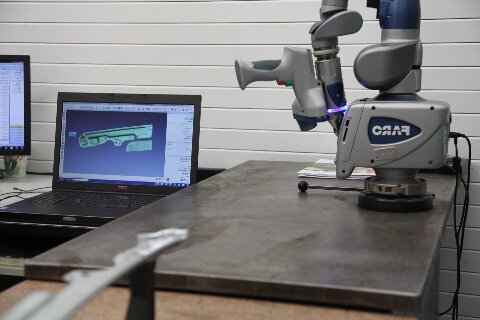Manufacturers often face challenges when shaping metal into complex curves and contours. Traditional methods can be time-consuming, costly, and prone to errors. Enter stretch forming – a versatile technique that offers precise, efficient results for creating curved metal components.
Stretch forming is a metal fabrication technique that stretches and bends metal over a die to create curved shapes. It uses tension to pull the material taut while forming it around a mold, resulting in uniform thickness and minimal spring-back. This method produces large, contoured parts with high dimensional accuracy.
Let’s explore how stretch forming works, its benefits, and its broad uses in modern manufacturing.
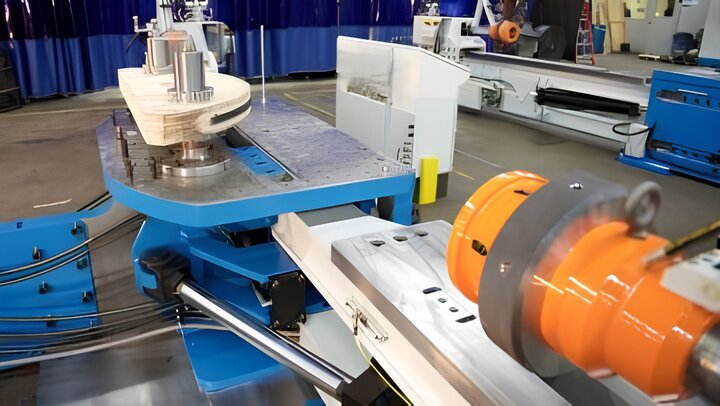
Understanding the Stretch Forming Process
The Science Behind Stretch Forming
Stretch forming relies on the principle of plastic deformation. We apply controlled tension to the metal sheet, stretching it beyond its yield point. This tension, combined with the shaping force of the die, allows us to create precise, curved forms.
The process involves carefully calculating material properties, stress distributions, and forming limits. Our engineers use advanced software to model and simulate the forming process, ensuring optimal results for each unique project.
Key Principles and Techniques
Several vital principles govern successful stretch forming:
- Material selection: We choose metals with appropriate flexibility and strength.
- Tension control: We carefully regulate the stretching force to avoid tearing or excessive thinning.
- Die design: Our forms are precisely engineered to achieve the desired final shape.
- Temperature management: Some materials benefit from heating during the forming process.
We employ various techniques to optimize results, including pre-stretching, multi-stage forming, and post-forming heat treatments.
Common Materials Used in Stretch Forming
Stretch forming works well with a range of metals, including:
- Aluminum alloys
- Stainless steel
- Titanium
- Copper alloys
- Low-carbon steel
Each material has unique properties that influence the forming process. We select the best material based on the specific requirements of each project, considering factors like strength, weight, corrosion resistance, and cost.
Types of Stretch Forming Techniques
Linear Stretch Forming
Linear stretch forming is our go-to method for creating long, curved parts. We clamp the metal sheet at both ends and stretch it over a stationary die. This technique produces components like aircraft wing skins and large architectural panels.
The process allows for precise control of material thickness and curvature. We can achieve complex shapes by adjusting the tension and die position during forming.
Rotary Stretch Forming
Rotary stretch forming is perfect for creating parts with varying cross-sections. We use a rotating die that moves along the length of the workpiece. This method produces components like aircraft fuselage sections and automotive body panels.
The rotating die provides excellent control over the forming process. We can create intricate shapes with changing profiles along the length of the part.
Compression Stretch Forming
Compression stretch forming combines stretching with compressive forces. We apply pressure to the material from both ends while it’s formed over the die. This technique is ideal for creating parts with tight radii and complex contours.
The added compression helps reduce material spring back and improves dimensional accuracy. We often use this method for aerospace components and high-precision parts.
Hot and Cold Stretch Forming
We perform stretch forming at room temperature (cold forming) and elevated temperatures (hot forming). Cold forming works well for many materials and applications. It’s cost-effective and doesn’t require additional heating equipment.
Hot forming involves heating the material before or during the forming process. This technique allows us to work with less ductile materials and create more extreme shapes. We use hot forming for materials like titanium and certain high-strength alloys.
Applications of Stretch Forming
Aerospace Industry
The aerospace sector relies heavily on stretch forming. We produce a wide range of aircraft components using this technique:
- Wing skins
- Fuselage panels
- Engine cowlings
- Tail sections
Stretch forming allows us to create large, curved parts with tight tolerances. The process maintains material strength while minimizing weight – crucial factors in aircraft design.
Automotive Industry
In automotive, stretch forming is crucial in producing sleek, aerodynamic designs. We use it to create:
- Body panels
- Roof sections
- Hood and trunk lids
- Fenders
The technique allows for complex curves and contours that enhance vehicle aesthetics and performance. It’s beneficial for low-volume production and specialty vehicles.
Architecture and Construction
Stretch forming finds extensive use in modern architecture. We create eye-catching building elements such as:
- Curved façade panels
- Decorative cladding
- Arched window frames
- Curved roof sections
The process allows architects to bring their bold, curved designs to life. It offers a cost-effective way to produce significant, uniformly curved metal components.
Electronics and Consumer Goods
Even in electronics and consumer products, stretch forming has its place. We use it to produce:
- Curved display housings
- Ergonomic device enclosures
- Sleek appliance panels
- Curved furniture components
The technique allows for smooth, seamless curves that enhance product aesthetics and ergonomics. It’s beneficial for creating durable, lightweight enclosures for electronic devices.
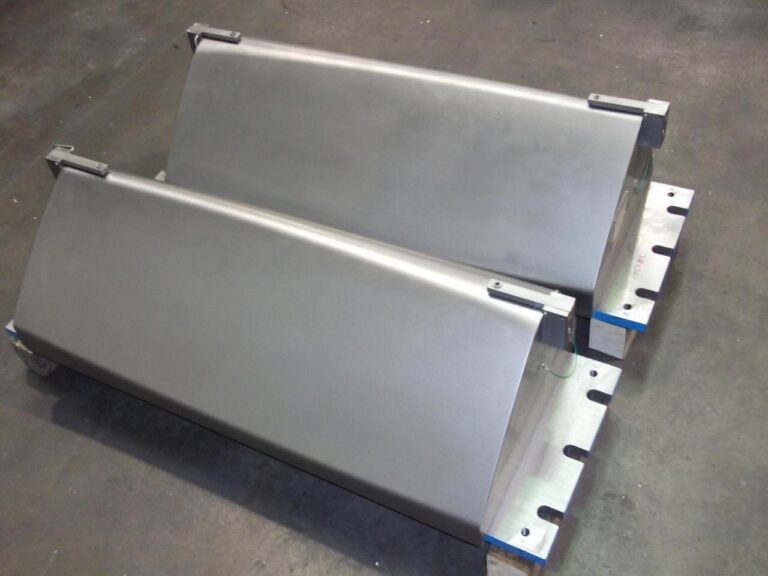
Advantages of Stretch Forming
Precision and Accuracy
Stretch forming delivers exceptional precision:
- Tight tolerances achievable
- Consistent results across batches
- Minimal material distortion
- Accurate replication of die shapes
We achieve exact parts, meeting strict specifications for critical applications.
Cost Efficiency
Stretch forming offers several cost benefits:
- Reduced material waste
- Faster production times
- Lower labor costs
- Minimal post-forming operations
These factors contribute to overall cost savings in manufacturing processes.
Versatility with Complex Shapes
The technique handles a wide range of shapes:
- Large, sweeping curves
- Compound contours
- Asymmetrical forms
- Varying thicknesses
We can create diverse geometries to meet unique design requirements.
Material Efficiency
Stretch forming maximizes material use:
- Minimal trimming needed
- Reduced scrap generation
- Efficient use of sheet metal
- Ability to form pre-cut blanks
This efficiency leads to less waste and lower material costs.
Challenges and Limitations
Material Springback
Springback poses a challenge in stretch forming:
- Metal tends to return to its original shape partially
- Requires compensation in die design
- It may need multiple forming steps
- Affects the final part’s accuracy
We carefully account for spring back to ensure dimensional accuracy.
Tooling Costs
Initial tooling investment can be significant:
- Custom dies are needed for each part
- High-quality materials required for dies
- Potential for long lead times
- Cost increases with part complexity
However, these costs often balance out in high-volume production.
Material Compatibility
Not all materials suit stretch forming:
- Limited to ductile metals
- Some alloys may crack or tear
- Thicker materials pose challenges
- Heat treatment may be necessary
We carefully select appropriate materials for each application.
Surface Finish Issues
Surface quality requires attention:
- Risk of scratches or marks from tooling
- Potential for orange peel texture
- Uneven stretching can cause inconsistencies
- May require post-forming finishing
Proper technique and tooling maintenance help minimize these issues.
Comparing Stretch Forming with Other Forming Techniques
Stretch Forming vs. Roll Forming
Stretch forming and roll forming are effective metal shaping techniques but serve different purposes.
Stretch forming excels at creating large, curved parts with complex contours. It offers greater flexibility in shape design and is ideal for low to medium production volumes.
Roll forming, on the other hand, is best for producing long, straight parts with constant cross-sections. It’s highly efficient for high-volume items like gutters or structural beams.
The choice between these methods depends on the part geometry, production volume, and material requirements.
Stretch Forming vs. Deep Drawing
Deep drawing and stretch forming create three-dimensional shapes from flat sheet metal, but they use different approaches.
Stretch forming maintains relatively uniform material thickness throughout the part. It’s excellent for ample, shallow curves and complex contours.
Deep drawing, in contrast, forms deeper, cup-like shapes. It allows for more dramatic depth changes but can result in varying wall thicknesses.
We choose these techniques based on the desired part shape, depth, and material distribution requirements.
Stretch Forming vs. Hydroforming
Hydroforming uses fluid pressure to shape metal, while stretch forming uses mechanical force and tension.
Stretch forming offers better control over material thickness and is generally more cost-effective for more significant parts. It’s also faster for many applications.
Hydroforming can create more complex internal geometries and is often used for tubular parts. It’s beneficial for creating parts with intricate details or varying wall thicknesses.
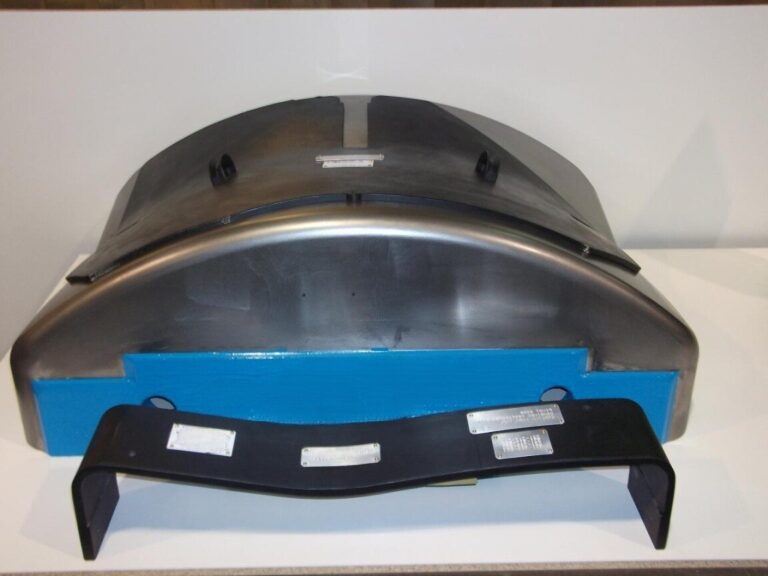
Critical Considerations in the Stretch Forming Process
Choosing the Right Material
Selecting the appropriate material is crucial for successful stretch forming. We consider several factors:
- Ductility: The material must have sufficient stretch capacity.
- Strength: We assess the material’s ability to maintain shape after forming.
- Thickness: Different thicknesses affect formability and final part properties.
- Surface finish: Some materials retain their finish better during forming.
We often work with aluminum alloys, stainless steel, and titanium. Each material behaves differently during forming, requiring specific techniques and tooling.
Designing for Stretch Forming
Effective design is critical to achieving optimal results in stretch forming. We focus on:
- Part geometry: Simple curves are more accessible to form than complex contours.
- Radius of curvature: Tighter radii may require special techniques or materials.
- Thickness variations: We account for potential thinning in high-stress areas.
- Edge conditions: Proper edge design prevents tearing and improves quality.
Our team works closely with clients to refine designs for manufacturability. We use advanced simulation software to predict forming outcomes and optimize designs.
Quality Control and Inspection
Rigorous quality control ensures consistently high-quality parts. Our process includes:
- Pre-forming material inspection: We check for defects or inconsistencies.
- In-process monitoring: We continuously assess forming parameters.
- Post-forming dimensional checks: We verify part geometry using precision tools.
- Surface inspection: We examine parts for scratches, wrinkles, or other imperfections.
We use advanced measurement techniques, including 3D scanning and coordinate measuring machines (CMMs). This ensures parts meet exact specifications and quality standards.
Conclusion
Stretch forming stands out as a versatile and efficient metal shaping technique. It offers unique advantages in creating significant, curved components with precision and consistency.
This process shines in various industries, from aerospace to architecture. Its ability to produce complex shapes while maintaining material integrity makes it invaluable for many applications.
Do you need a reliable sheet metal parts manufacturer? Shengen is the place to go. We specialize in sheet metal laser cutting, bending, surface finish, and CNC Machining. Reach out to Shengen Today and seek help from professionals!
FAQs
What are the defects of stretch forming?
Common defects in stretch forming include wrinkling, tearing, and uneven thickness distribution. Wrinkling can occur if tension is insufficient, while excessive tension may lead to tearing. Improper die design or material selection can result in uneven stretching, causing thickness variations across the part.
Can stretch forming be used on all metals?
Stretch forming works best with ductile metals that can withstand significant elongation without fracturing. While it’s effective for many alloys, it’s unsuitable for all metals. Materials like aluminum, stainless steel, and titanium respond well to stretch forming. However, this process may not be appropriate for brittle metals or those with low flexibility.
How does stretch forming improve material efficiency?
Stretch forming enhances material efficiency by minimizing waste and optimizing material usage. The process allows for the formation of complex shapes from a single piece of metal, reducing the need for additional joining or welding operations. It also requires less trimming than other forming methods, resulting in less scrap.
Is stretch forming cost-effective for small production runs?
The cost-effectiveness of stretch forming for small production runs depends on several factors. For complex or large parts, stretch forming may prove more economical than alternative methods, even in smaller quantities. However, for tiny runs, the tooling investment might outweigh the benefits.
Hey, I'm Kevin Lee

For the past 10 years, I’ve been immersed in various forms of sheet metal fabrication, sharing cool insights here from my experiences across diverse workshops.
Get in touch

Kevin Lee
I have over ten years of professional experience in sheet metal fabrication, specializing in laser cutting, bending, welding, and surface treatment techniques. As the Technical Director at Shengen, I am committed to solving complex manufacturing challenges and driving innovation and quality in each project.

